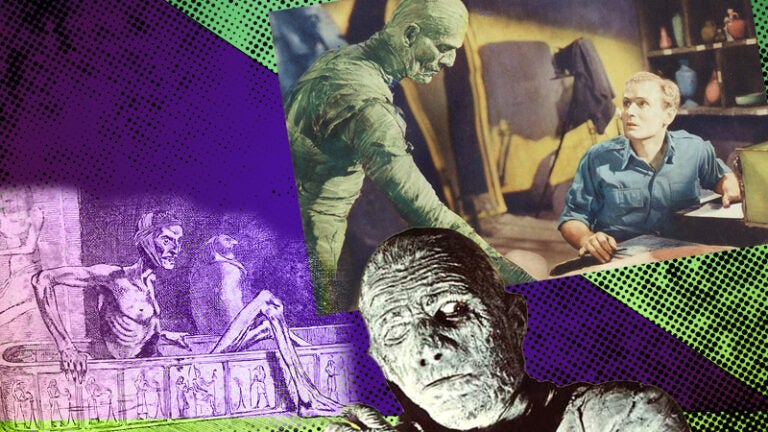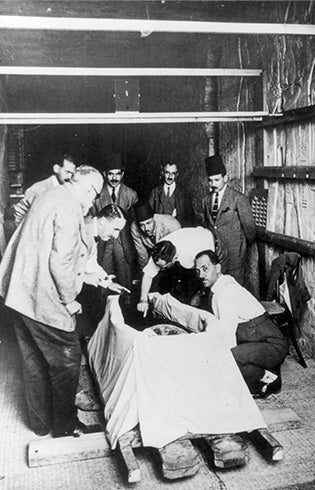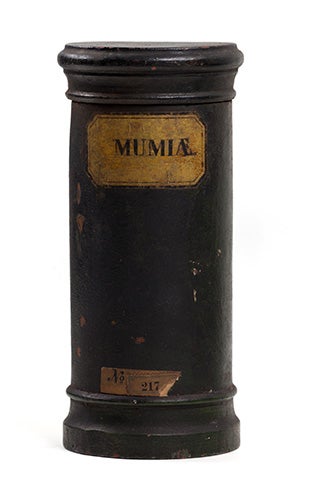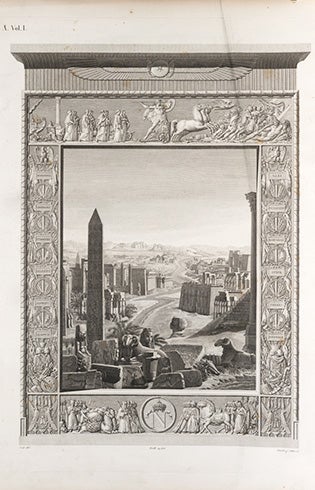
Magic, medicine and eternal love: why mummies still mesmerize
Key points:
Nov. 4 marks the 100th anniversary of the opening of King Tut’s tomb, which some believe unleashed a curse.
Our fascination with mummies actually goes back to medieval times, and even made its way into medicinal cures.
In the modern era, mummy movies have become a means to process collective anxiety and guilt over the historical disruption of graves.
On Nov. 4, 1922, archaeologist Howard Carter broke open the sealed doors of the tomb of King Tutankhamun, revealing a sarcophagus containing the ancient Egyptian pharaoh’s mummified remains and a vast spread of riches. It was a remarkable find. Yet it was a morbid curse, not the gold treasure, that would launch the discovery into the sphere of the mythical.
Howard Carter and his archeological crew prepare to make the first incision into the mummy of King Tut. (Image source: Wikimedia Commons.)

Shortly after the opening of the tomb, the expedition’s financer, Lord Carnarvon, died from an infected mosquito bite. Newspapers picked up the incident, falsely claiming that a warning against those who entered the tomb had been inscribed above the doorway.
The “curse of the mummy” soon became as fascinating to the public as any of King Tut’s gold or silver. The 1932 film The Mummy loosely adapted this story for the silver screen and ever since, it seems, cursed mummies have occupied a permanent place in our cultural consciousness. They’re a staple in monster movies and creepy books, and have joined our repertoire of standard Halloween costumes alongside the vampire and witch.
Yet, the “mummy madness” incited by King Tut was just one of many waves of enthusiasm for the bandaged remains that have swept through the West since the Middle Ages. A closer look at why we remain so fascinated by these crumbling creatures reveals a rich array of origins, from a long-standing belief in Egyptian magic to guilt over the behavior of colonial empires to a yearning for undying love.
A teaspoon of sugar makes the mummy powder go down
The West’s interest in mummies arose alongside the idea that the ancient Egyptians possessed a lost form of magic. A passage in Exodus that mentions the “pharaoh’s magicians.” along with the strange, undeciphered hieroglyphics left behind by bygone Egyptian civilizations, ignited the imaginations of medieval Europe.

“This all brought about the view of ancient Egypt as an occult opposition to Judeo-Christian beliefs,” says Thea Tomaini, professor (teaching) of English. “Medieval Europeans thought that hieroglyphs were picture writing. So, not only were they mysterious, and connected to the magic of Pharaoh’s magicians, but they were graven images and specifically idolatrous.”
Mummies also played a strange, important role in early European medicine. Throughout the Middle Ages, the Renaissance and even into the Victorian era, Europeans used powdered mummy remains for healing powders and potions.
This originally arose from the Arabic practice of using bitumen or “mummia” in Persian, a sticky form of petroleum that seeps naturally from the Earth in some parts of the Middle East, as a curative.
European apothecaries read about this substance in Arabic medicinal texts and soon a robust bitumen trade between Europe and the Middle East rose up. Eventually, purveyors of the material resorted to grinding up ancient Egyptian mummies, whose preservation techniques appeared to use bitumen, into a powder to satisfy demand.
Over time, bitumen’s allure was supplanted by the newer, romanticized notion of consuming the literal flesh of mummies. “They thought that mummy powder had magical powers. This connected the idea of the mystique of ancient Egypt with the idea that the bodies of the ancient Egyptians themselves had this magic,” says Tomaini.
Death, unwrapped

The metaphorical appetite for mummies was later reinforced by Napoleon’s excursion into Egypt at the turn of the 19th century. The detailed engravings of art, pyramids and temples published afterwards inspired art, literature, architecture and fashion across Europe and America.
It also sparked enthusiasm for a new type of party activity: mummy unrolling. Guests would watch while the host unwound the bandages from a mummy that had been imported from Egypt. Onlookers could examine up close the hair, bones and jewelry of the dead.
Mummies also made their way into museums and traveling shows, drawing large crowds who could gaze with frank curiosity at withered remains. These exhibits overlapped with the rise of funeral parlors. More and more families outsourced caring for the dead to morticians so that, in the modern era, a mummy on exhibit may be first corpse a person sees.
“Mummies permit us to gaze upon dead bodies in safe circumstances. They thrill us with their exoticism and are a comforting replacement for the historical reality of handling the bodies of our own dead,” says Diana Blaine, professor (teaching) of gender and sexuality studies.
All this unwrapping and gawking seems to have sparked persistent feelings of guilt, however, which might explain why we also associate mummies with ire.
“Most people, no matter where they are on the planet, have a deep religious or moral connection to the idea that they will rest in peace,” says Tomaini. “The fact that you’re digging up mummies, unwrapping them at dinner parties and putting them in museums, really hits at this deeper fear in human beings that your final resting place will be violated by someone in some future time.”
It was also this era, long before King Tut’s discovery, that produced the first stories of a resurrected mummy and a mummy’s curse. The Mummy! written in 1827 by Jane C. Loudon featured a reanimated mummy, and Louisa May Alcott’s 1869 short story “Lost in a Pyramid” centered on haunted seeds taken from a pharaoh’s tomb. Notably, the earliest tales about vengeful mummies were written by women, who may have seen the violation of graves as analogous to rape, according to anthropologist and noted Egyptologist Jasmine Day.
Love springs eternal
Our collective guilt over the treatment of mummies rather obviously spilled over into mummy movies. Their plots invariably involve an intrusive archeologist incurring the wrath of a mummified pharaoh after disturbing his grave.
Much of this can be linked to our anxiety over the exploits of colonial empires, who dug up graves and removed thousands of mummies with little concern for local customs.
“I think there’s a lot of colonialist guilt wrapped up in these stories. We’re having to ask ourselves, ‘What if my final resting place was violated by someone from a faraway land who was interested not just in my things, or my resting place, but who wanted to violate my body by unwrapping it of its linen, taking my jewelry off, and cutting me to pieces?’” says Tomaini. In order to remove King Tut’s gold wristbands and funerary mask, for instance, archeologists pulled apart his joints and then fashioned them back together.
Processing guilt isn’t all that these films are about, however. “What really fires the plot and gives it its energy, is the theme of lost love,” says Leo Braudy, University Professor, professor of English and art history, and Leo S. Bing Chair in English and American Literature.
In the 1932 film The Mummy and its 1999 remake, much of the plot revolves around the resurrected mummy’s ancient love for Princess Ankhesenamun, which is then transposed onto a modern woman he meets after he is awakened. “That’s a theme in many other monster movies, like Dracula. Is love eternal, does it last through time?” says Braudy.
And, of course, mummy movies explore one of the biggest questions of all: Can we defeat death? The resurrection powers of mummies will likely continue to fascinate as long as immortality eludes us.